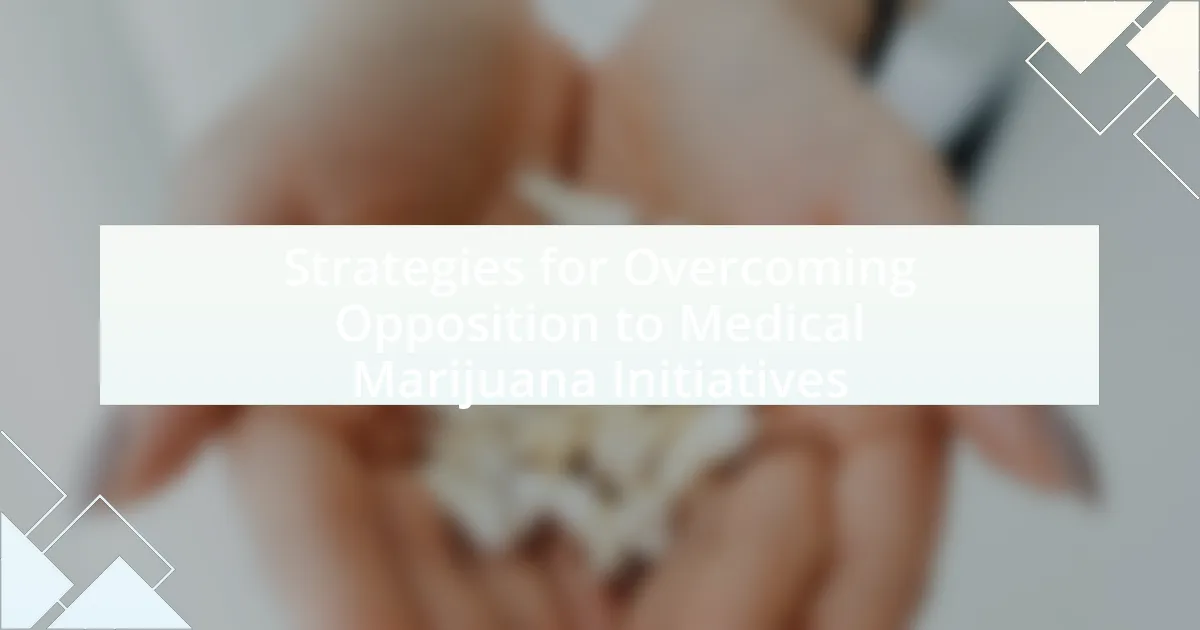The article focuses on strategies for overcoming opposition to medical marijuana initiatives, highlighting the main challenges such as legal restrictions, social stigma, and insufficient scientific research. It examines community opposition rooted in public health concerns and misconceptions about marijuana use, as well as the influence of political factors and healthcare professionals’ skepticism. The article emphasizes the importance of education, coalition-building, and transparent communication to address fears and misinformation, while also discussing the role of advocacy and grassroots movements in shaping public perception and policy change. Key strategies for engaging stakeholders and measuring the impact of initiatives are also outlined, providing a comprehensive overview of effective approaches to advance medical marijuana initiatives.

What are the main challenges to medical marijuana initiatives?
The main challenges to medical marijuana initiatives include legal restrictions, social stigma, and lack of scientific research. Legal restrictions arise from varying state and federal laws that create confusion and limit access to medical marijuana. Social stigma persists due to misconceptions about marijuana use, which can hinder public support and legislative progress. Additionally, the lack of comprehensive scientific research limits understanding of medical marijuana’s efficacy and safety, making it difficult to gain acceptance among healthcare professionals and policymakers. These challenges collectively impede the advancement and implementation of medical marijuana initiatives.
Why do some communities oppose medical marijuana initiatives?
Some communities oppose medical marijuana initiatives due to concerns about public health, safety, and social implications. These communities often fear that legalizing medical marijuana may lead to increased drug abuse, impaired driving, and a general decline in community standards. Research indicates that areas with higher rates of marijuana availability may experience a rise in emergency room visits related to substance use, which reinforces these concerns. Additionally, opposition can stem from cultural or moral beliefs that view marijuana use negatively, further solidifying resistance to such initiatives.
What misconceptions exist about medical marijuana?
Misconceptions about medical marijuana include the belief that it is simply a cover for recreational use, that it lacks medical benefits, and that it is highly addictive. Many opponents argue that medical marijuana is often abused for recreational purposes; however, studies show that medical marijuana can effectively treat conditions such as chronic pain, epilepsy, and multiple sclerosis. Additionally, research published in the Journal of the American Medical Association indicates that while some individuals may develop a dependency, the addiction rates for medical marijuana are lower compared to other substances like opioids. These misconceptions can hinder the acceptance and implementation of medical marijuana initiatives, despite its proven therapeutic benefits.
How do political factors influence opposition?
Political factors significantly influence opposition by shaping public perception, legislative support, and funding for initiatives. For instance, political parties may align their platforms against medical marijuana based on ideological beliefs, which can mobilize opposition groups and sway public opinion. Additionally, the presence of influential political figures who advocate against medical marijuana can lead to increased resistance, as seen in states where governors or legislators actively campaign against legalization efforts. Furthermore, political lobbying from established industries, such as pharmaceuticals or alcohol, can create financial barriers to medical marijuana initiatives, thereby intensifying opposition. These dynamics illustrate how political factors directly impact the level and nature of opposition faced by medical marijuana initiatives.
What role do healthcare professionals play in the opposition?
Healthcare professionals play a critical role in the opposition to medical marijuana initiatives by influencing public perception and policy through their expertise and credibility. Their positions often stem from concerns about the lack of comprehensive research on the safety and efficacy of medical marijuana, which can lead to skepticism among policymakers and the public. For instance, a survey conducted by the American Medical Association indicated that many physicians remain cautious about endorsing medical marijuana due to insufficient clinical evidence supporting its use for various conditions. This cautious stance can significantly impact legislative discussions and the overall acceptance of medical marijuana initiatives.
How do medical associations view medical marijuana?
Medical associations generally support the use of medical marijuana for specific therapeutic purposes, recognizing its potential benefits in treating certain conditions. For instance, the American Medical Association (AMA) has acknowledged that marijuana can be effective for pain management, nausea from chemotherapy, and other medical issues. Additionally, the American Academy of Pediatrics (AAP) has expressed that while more research is needed, there is a growing acceptance of medical marijuana as a treatment option, particularly for children with severe epilepsy. These positions reflect a shift towards a more favorable view of medical marijuana within the medical community, driven by emerging evidence and patient advocacy.
What concerns do doctors have regarding prescribing medical marijuana?
Doctors have several concerns regarding prescribing medical marijuana, primarily related to its safety, efficacy, and legal status. Many physicians worry about the lack of comprehensive clinical research supporting the therapeutic benefits of medical marijuana, which complicates their ability to make informed decisions. Additionally, concerns about potential side effects, such as cognitive impairment and dependency, further complicate the prescribing process. The legal ambiguity surrounding medical marijuana, varying state laws, and the potential for federal prosecution also create hesitation among doctors to prescribe it. These factors contribute to a cautious approach in integrating medical marijuana into treatment plans, as evidenced by surveys indicating that a significant percentage of healthcare providers express uncertainty about its use in clinical practice.
How does public perception affect medical marijuana initiatives?
Public perception significantly influences medical marijuana initiatives by shaping legislative support and public policy. When a majority of the population views medical marijuana positively, it increases the likelihood of lawmakers endorsing legalization efforts, as seen in states like California and Colorado, where public support led to successful ballot measures. Conversely, negative perceptions can hinder progress, as evidenced by states where opposition remains strong, resulting in stalled or rejected initiatives. Research indicates that public attitudes are often swayed by media representation and educational campaigns, which can either promote understanding or perpetuate stigma surrounding medical marijuana use.
What are the common fears associated with medical marijuana use?
Common fears associated with medical marijuana use include concerns about addiction, impaired cognitive function, and potential negative health effects. Many individuals worry that using medical marijuana may lead to dependency, as studies indicate that approximately 9% of users may develop a cannabis use disorder. Additionally, there are fears regarding cognitive impairment, particularly in adolescents, as research shows that marijuana can affect memory and learning. Lastly, some people express concerns about the long-term health impacts, such as respiratory issues from smoking marijuana, which has been documented in various studies.
How can misinformation impact public opinion?
Misinformation can significantly distort public opinion by shaping perceptions and beliefs based on false or misleading information. For instance, studies have shown that misinformation regarding the effects of medical marijuana can lead to increased opposition among the public, as individuals may rely on inaccurate claims about its safety and efficacy. A survey conducted by the Pew Research Center found that 62% of Americans believe that misinformation about medical marijuana affects their views on its legalization. This demonstrates that when people are exposed to misleading narratives, their attitudes and decisions regarding medical marijuana initiatives can be adversely influenced, ultimately hindering progress in policy acceptance and implementation.

What strategies can be employed to overcome opposition?
To overcome opposition to medical marijuana initiatives, advocates can employ strategies such as education, coalition-building, and addressing concerns through transparent communication. Education involves providing factual information about the benefits and safety of medical marijuana, which can counteract misinformation and fears. Coalition-building with healthcare professionals, patients, and community leaders can create a united front that amplifies the message and demonstrates widespread support. Additionally, addressing specific concerns—such as potential health risks or regulatory issues—through open dialogue can help alleviate fears and build trust. Research indicates that states with comprehensive educational campaigns and strong coalitions have seen increased public support for medical marijuana initiatives, highlighting the effectiveness of these strategies.
How can education and awareness campaigns help?
Education and awareness campaigns can help by increasing public understanding of medical marijuana’s benefits and addressing misconceptions. These campaigns provide factual information about the therapeutic uses of medical marijuana, which can lead to more informed opinions and reduce stigma. For instance, a study published in the Journal of Psychoactive Drugs found that educational interventions significantly improved knowledge and attitudes toward medical marijuana among participants. By fostering a well-informed community, these campaigns can create a supportive environment for medical marijuana initiatives, ultimately influencing policy decisions and public acceptance.
What key messages should be included in educational campaigns?
Key messages in educational campaigns about medical marijuana initiatives should emphasize the scientific evidence supporting its medical benefits, the safety profile compared to traditional medications, and the importance of patient access to treatment. Research indicates that medical marijuana can effectively alleviate symptoms for conditions such as chronic pain, epilepsy, and multiple sclerosis, as documented in studies published in journals like the Journal of the American Medical Association. Additionally, highlighting the regulatory frameworks that ensure quality and safety can help address concerns about misuse. By focusing on these key messages, campaigns can effectively inform the public and policymakers, fostering a more supportive environment for medical marijuana initiatives.
How can success stories be effectively communicated?
Success stories can be effectively communicated by utilizing clear narratives that highlight specific outcomes and personal testimonials. This approach engages the audience emotionally and provides relatable examples of the benefits of medical marijuana. For instance, presenting case studies that detail individual patient experiences, including improvements in quality of life and health outcomes, can substantiate claims about the efficacy of medical marijuana. Research indicates that storytelling enhances retention of information, making it a powerful tool in advocacy efforts. A study published in the Journal of Health Communication found that narratives significantly increase the likelihood of changing attitudes toward health-related issues, including medical marijuana.
What role does advocacy play in supporting medical marijuana initiatives?
Advocacy plays a crucial role in supporting medical marijuana initiatives by mobilizing public support, influencing policymakers, and educating communities about the benefits of medical cannabis. Advocacy groups, such as the National Organization for the Reform of Marijuana Laws (NORML), actively campaign for legislative changes, providing research and testimonials that highlight the therapeutic benefits of medical marijuana for conditions like chronic pain and epilepsy. For instance, a 2017 study published in the Journal of the American Medical Association found that states with medical marijuana laws experienced a significant reduction in opioid prescriptions, underscoring the potential of cannabis as an alternative treatment. This evidence, coupled with grassroots efforts, helps to shift public perception and reduce stigma, ultimately leading to more favorable legislation and increased access to medical marijuana for patients in need.
How can grassroots movements influence policy change?
Grassroots movements can influence policy change by mobilizing community support, raising awareness, and advocating for specific legislative reforms. These movements often utilize strategies such as organizing protests, engaging in direct lobbying, and leveraging social media to amplify their message. For instance, the successful legalization of medical marijuana in several U.S. states can be attributed to grassroots efforts that educated the public on the benefits of medical cannabis, thereby shifting public opinion and pressuring lawmakers to act. Research indicates that states with strong grassroots campaigns saw a higher likelihood of passing medical marijuana initiatives, demonstrating the effectiveness of community-driven advocacy in shaping policy outcomes.
What strategies can advocates use to engage policymakers?
Advocates can engage policymakers by utilizing data-driven arguments, building coalitions, and fostering personal relationships. Data-driven arguments provide evidence of the benefits and safety of medical marijuana, which can influence policymakers’ decisions. For instance, studies have shown that states with medical marijuana laws experience lower opioid overdose rates, demonstrating a public health benefit that can sway legislative support. Building coalitions with diverse stakeholders, including healthcare professionals and patient advocacy groups, amplifies the message and demonstrates broad support for medical marijuana initiatives. Additionally, fostering personal relationships through regular communication and meetings with policymakers can create trust and open channels for dialogue, making it easier to advocate for policy changes.
How can collaboration with healthcare professionals be fostered?
Collaboration with healthcare professionals can be fostered through structured communication and interdisciplinary training. Establishing regular meetings and forums for discussion allows healthcare professionals to share insights and concerns regarding medical marijuana initiatives. Additionally, incorporating medical marijuana education into healthcare training programs enhances understanding and acceptance among professionals. Research indicates that effective communication and education can significantly improve collaboration, as evidenced by a study published in the Journal of Medical Education, which found that interdisciplinary training increased cooperation among healthcare teams by 30%.
What partnerships can be formed to support medical marijuana initiatives?
Partnerships that can be formed to support medical marijuana initiatives include collaborations with healthcare organizations, patient advocacy groups, and academic institutions. Healthcare organizations can provide clinical evidence and support for the therapeutic benefits of medical marijuana, while patient advocacy groups can mobilize community support and raise awareness about patient needs. Academic institutions can contribute research and data to validate the efficacy and safety of medical marijuana, thereby strengthening the case for its use. These partnerships can collectively enhance credibility and foster a more informed public dialogue, which is essential for overcoming opposition to medical marijuana initiatives.
How can healthcare professionals be educated about the benefits of medical marijuana?
Healthcare professionals can be educated about the benefits of medical marijuana through targeted training programs and evidence-based resources. These educational initiatives should include comprehensive workshops, online courses, and seminars that focus on the pharmacology, therapeutic applications, and clinical outcomes associated with medical marijuana use. Research indicates that healthcare providers who receive formal education on medical marijuana are more likely to support its use; for instance, a study published in the Journal of Pain and Symptom Management found that 70% of physicians who attended educational sessions reported increased knowledge and comfort in discussing medical cannabis with patients. Additionally, providing access to peer-reviewed studies and clinical guidelines can further enhance understanding and acceptance among healthcare professionals.

What are the best practices for implementing these strategies?
The best practices for implementing strategies to overcome opposition to medical marijuana initiatives include engaging stakeholders, providing clear and factual information, and building coalitions. Engaging stakeholders, such as healthcare professionals and community leaders, fosters trust and encourages open dialogue, which can mitigate resistance. Providing clear and factual information about the benefits and risks of medical marijuana helps dispel myths and misinformation, as evidenced by studies showing that informed communities are more likely to support medical marijuana policies. Building coalitions with advocacy groups and local organizations strengthens the movement by uniting diverse voices and resources, enhancing credibility and outreach efforts.
How can stakeholders effectively measure the impact of their initiatives?
Stakeholders can effectively measure the impact of their initiatives by utilizing a combination of quantitative and qualitative metrics tailored to specific goals. For instance, they can track changes in public opinion through surveys before and after the initiative’s implementation, which provides measurable data on shifts in perception. Additionally, analyzing usage statistics of medical marijuana, such as patient enrollment in programs or prescription rates, offers concrete evidence of the initiative’s reach and effectiveness. Research conducted by the National Academies of Sciences, Engineering, and Medicine in 2017 found that increased access to medical marijuana correlates with reduced opioid prescriptions, highlighting a tangible impact of such initiatives. By employing these methods, stakeholders can gain a comprehensive understanding of their initiatives’ effectiveness and areas for improvement.
What metrics should be used to assess public opinion changes?
To assess public opinion changes regarding medical marijuana initiatives, key metrics include survey data, social media sentiment analysis, and voting patterns. Survey data provides quantitative insights into public attitudes, with studies indicating that support for medical marijuana has increased from 34% in 2001 to over 90% in recent years, according to a Gallup poll. Social media sentiment analysis evaluates public discourse and emotional reactions, revealing shifts in perception over time. Voting patterns in referendums or elections serve as a direct measure of public opinion, with states like California and Colorado showing significant support for medical marijuana legalization in recent votes. These metrics collectively offer a comprehensive view of how public opinion evolves.
How can feedback be gathered from the community to improve strategies?
Feedback can be gathered from the community to improve strategies by utilizing surveys, public forums, and social media engagement. Surveys can be distributed both online and offline to collect quantitative data on community opinions regarding medical marijuana initiatives. Public forums allow for open discussions where community members can voice their concerns and suggestions directly, fostering a sense of involvement. Social media platforms can be leveraged to reach a broader audience, enabling real-time feedback and interaction. According to a study published in the Journal of Medical Internet Research, community engagement through these methods significantly enhances the effectiveness of health-related initiatives by ensuring that strategies align with public sentiment and needs.
What are the common pitfalls to avoid when advocating for medical marijuana?
Common pitfalls to avoid when advocating for medical marijuana include relying on anecdotal evidence, failing to address legal and regulatory concerns, and neglecting to engage with opposing viewpoints. Advocates often use personal stories instead of scientific research, which can undermine credibility; studies show that evidence-based arguments are more persuasive. Additionally, not being informed about the legal landscape can lead to miscommunication and mistrust among stakeholders, as regulations vary significantly by state. Lastly, dismissing opposing views can alienate potential allies; engaging in constructive dialogue can foster understanding and support.
How can advocates ensure they are addressing community concerns?
Advocates can ensure they are addressing community concerns by actively engaging with community members through surveys, public forums, and focus groups to gather input and feedback. This engagement allows advocates to identify specific issues and priorities that matter to the community, ensuring that their initiatives align with local needs. Research indicates that community involvement in decision-making processes leads to higher levels of trust and support for initiatives, as seen in studies conducted by the American Public Health Association, which highlight the importance of stakeholder engagement in public health initiatives.
What strategies can prevent backlash from opposition groups?
Engaging in transparent communication is a key strategy to prevent backlash from opposition groups regarding medical marijuana initiatives. By providing clear, factual information about the benefits and safety of medical marijuana, stakeholders can address misconceptions and fears. Research indicates that educational campaigns that include testimonials from medical professionals and patients can significantly reduce opposition, as seen in the 2016 study published in the Journal of Drug Policy Analysis, which found that informed communities were more supportive of medical marijuana policies. Additionally, involving opposition groups in the dialogue and decision-making process fosters collaboration and reduces resistance, as demonstrated by successful initiatives in states like California, where stakeholder engagement led to broader acceptance of medical marijuana laws.
What practical tips can help in overcoming opposition to medical marijuana initiatives?
To overcome opposition to medical marijuana initiatives, advocates should focus on education, community engagement, and building coalitions. Educating the public about the medical benefits of marijuana, supported by studies such as those published in the Journal of Pain Research, can dispel myths and misinformation. Engaging with community members through forums and discussions fosters understanding and addresses concerns directly. Additionally, forming coalitions with healthcare professionals, patient advocacy groups, and local businesses can create a united front, demonstrating broad support for the initiative. These strategies have proven effective in various states where medical marijuana legislation has been successfully passed.

Leave a Reply